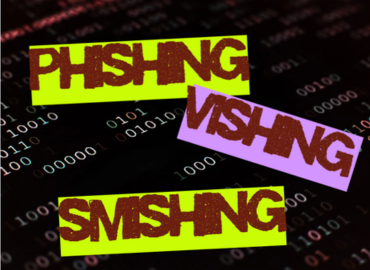Vishing vs Phishing: Know the Difference

It can feel like there is a new term for cyberattacks to learn every day. But knowing the different types of attacks and knowing what to look for can mean the difference between a secure network and a multi-million dollar data breach.
In this article, we’ll discuss vishing vs phishing attacks, what they are and how to prevent them.
What is Vishing or Voice Phishing?
Vishing, or “voice phishing,” is a type of fraudulent phone call. The goal is the same as other phishing attempts, to gain access to a victim’s finances or sensitive data.
According to TrueCaller Insights 2024 U.S. Spam and Scam Report, “1 in 4 Americans reported losing an average of $452 to scams, totalling over $25.4 billion.”
Because the victim cannot see the person on the other end of the line, they cannot verify the other person's credentials, making a vishing attack easier to pull off than a face-to-face scam.
Examples of Vishing Attacks
It’s helpful to know what to look out for, so below are several examples of common vishing attacks.
- A Call From Your Bank or Financial Institution
The victim receives a phone call or a Short Message Service (SMS) from someone claiming to be a representative from their bank or other financial institution. They’re informed that there’s an issue with their bank account, and to resolve the issue, they’ll need their account information.
- Social Security Number Suspended
Someone claiming to be calling from the IRS or Social Security department claiming that your Social Security number is suspended and that to resolve the issue, you must verify your SSN to continue.
- Technical Support
This example can start as an email or SMS that requests you call a phone number to resolve an issue with your computer or utility bill.
How to Prevent Vishing Attacks
Luckily, there are simple ways to avoid falling victim to vishing attacks. Below are some easy best practices to follow.
- Never click on links in text messages from an unverified source.
If you’re unsure if a message is legitimate, navigate to the main website of the company the original message claims to be from and contact their support team directly.
2. Do not disclose personal information to someone who contacted you without forewarning.
If you have been contacted without being properly notified, do not give out any personally identifying information like your name, address, SSN or credit card number.
3. Add your company’s number to the National Do Not Contact Registry
This is a simple, one-and-done step to help protect yourself and your company from unwanted calls. Once you are added to the list, you will always be on the registry.
What is Phishing?
Normally done through email, phishing attacks target individuals, usually via malicious links, to obtain sensitive information from a company. Phishing is, by far, the most common cybercrime affecting more than 300,000 people in 2021.
Examples of Phishing Attacks
There are countless examples of phishing, but we will discuss the top 3 most common examples of phishing attacks.
- Receiving an email from a legitimate company saying there is a billing issue
- “Reset Your Password” emails
- An email from your CEO asking to send them gift cards or text them for further instruction
How to Prevent Phishing Attacks
Phishing attempts are getting more sophisticated, but there are still practical ways to protect yourself and your company’s data.
- Configure spam filters and email security solutions
IT departments and service providers should prioritize configuring business email accounts and inboxes with stringent spam filters and additional email security protocols.
2. Invest in security awareness training
Educating employees can be your best defense in the fight against cyber attacks. Teaching others what to look out for will help protect your company from falling for phishing attempts.
3. Consult an experienced cybersecurity partner
Sometimes, it’s best to call in the experts. To ensure your company is prepared against cyber attacks,, contact SSE for a complimentary consultation to discover potential vulnerabilities and determine the best solutions for your company.
What are the differences between phishing and vishing?
Although both are considered cyber attacks to gain financial advantages by obtaining sensitive information, the method in which they are carried out is the main difference between phishing and vishing.
Vishing is done through voice communication, while sometimes being triggered by an email or text message. Phishing attacks are made primarily through email and text-based messaging mediums.
Protect Your Business with SSE Cybersecurity Services
We take cybersecurity very seriously—it’s all we do. Let us put our cybersecurity expertise to work for your business, implementing best practices, identifying vulnerabilities and protecting you against vishing and phishing attacks.
Schedule your initial consultation with a cybersecurity expert today!
Additional Blog Posts

CMMC Deadlines: Defense Contractors Face High-Stakes Compliance Timelines
As the U.S. Department of Defense accelerates enforcement of the Cybersecurity Maturity Model Certification (CMMC), thousands of Defense Industrial Base…
DOJ Ramps Up Cyber-Enforcement on Defense Contractors
The Department of Justice’s recent $4.6 million settlement with defense contractor MORSECORP sends a clear message to the Defense Industrial…
